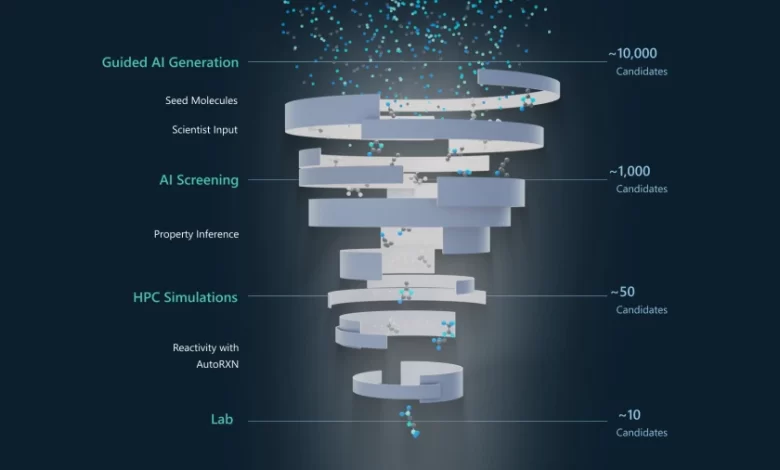Microsoft’s New Release Taps Generative AI, Quantum to Boost Molecular Research

Insider Brief
-
- Microsoft is releasing two new features to enhance the productivity and accessibility of research in chemistry and materials science.
- These updates are in line with the company’s overall mission to empower global scientific advances by leveraging AI, quantum and cloud high-performance computing (HPC).
- Microsoft and its partners are working toward offering a quantum supercomputer that can simulate interactions of molecules and atoms at the quantum level, according to the company blog.
- Image: A conceptual view of Generative Chemistry—a discovery pipeline that simulates thousands of previously unknown molecules and filters them through a series of screening steps to suggest several promising candidates for specific applications. (Microsoft)
Several important questions are — almost chronically — debated by quantum experts: Can quantum be used before they are fully developed, can quantum and artificial intelligence be integrated with scalability and what sorts of tasks will these new machines master first?
Microsoft has taken a swing at all three questions with its announcement that the company has introduced significant updates to its Azure Quantum Elements platform, according to Dr. Nathan Baker, product leader, Azure Quantum Elements, Microsoft, writing about the updates on the Microsoft Azure Quantum Blog. The company is also adding a twist by incorporating generative AI into the mix of tools that will be available to scientific teams.
Specifically, Microsoft is releasing two new features — Generative Chemistry and Accelerated DFT — to enhance the productivity and accessibility of research in chemistry and materials science so that scientists can discover and analyze molecular compounds, among other investigations, more effectively and efficiently. The company adds that its advanced quantum computing capabilities will be integrated into its platform.
On a higher level, the blog suggests that these updates are in line with the company’s overall mission to empower global scientific advances by leveraging AI, quantum and cloud high-performance computing (HPC). Ultimately, these efforts are laying the groundwork for a future quantum supercomputer, which will unlock discoveries previously hidden due to computational limitations, according to the blog.
As Baker writes: “Advances in AI and quantum computing have the potential to help researchers solve global scientific challenges. In the future, we plan to offer a quantum supercomputer that can simulate interactions of molecules and atoms at the quantum level, which is beyond the reach of classical computers. This capability is expected to transform research and innovation across many industries.”
Although this is the ultimate vision, it’s important to note that the company and its partners are not waiting for a quantum supercomputer — they believe that quantum can begin delivering on its promise of solving computationally tough problems today.
The Process — And The Pain — of Discovery
One of the biggest challenges in chemistry — if not science — is the narrowing down the vast number of potential molecules to find those suited for specific applications. Generative Chemistry aims to simplify this and ease the discovery and design process to find new compounds.
Baker writes on the blog: “There are hundreds of millions of known molecular compounds and substances and many more remain to be discovered. In the field of chemistry, a major challenge is narrowing down an enormous number of candidate molecules to find the few that are best suited for a particular application. This challenge results in the streetlight effect, which is when the vast number of possibilities is reduced to a reasonable size, not based on the properties of the compounds, but by focusing only on those that have been studied previously.”
Traditional methods rely heavily on databases of known compounds, limiting the scope of discovery, Baker added. Generative Chemistry, however, uses generative AI to explore a broader range of potential molecules, including those previously unknown.
“Generative AI helps bring to light a much larger portion of the estimated 1o^60 possible combinations of atoms so that scientists are presented with novel candidates that are likely to serve the intended purpose,” he writes.
Completing in Days What Took Months
The company explains that the molecular discovery process involves several steps.
Initially, scientists provide desired molecular characteristics and any reference molecules. The system then generates seed molecules from a dataset, which are used to initiate AI-driven generation of candidate molecules. These candidates are screened using AI-based models to predict properties such as boiling point, density, and solubility. A feedback loop refines the selection, and synthesis pathways are predicted to assess the feasibility of laboratory creation. The final step involves HPC simulations to evaluate electronic properties, narrowing the pool to the most promising candidates.
Microsoft reports that this entire process, which once took months or even years, can now be completed in days. This efficiency is expected to accelerate advancements in fields such as pharmaceuticals and sustainable materials.
Accelerated DFT: Speeding Up Quantum Mechanical Simulations
Density functional theory (DFT) is a cornerstone of computational chemistry. DFT is a computational quantum mechanical modeling method used to investigate the electronic structure of atoms, molecules and condensed matter systems. It leverages the principles of quantum mechanics to predict properties such as energy levels, electron density and molecular orbitals. Beyond chemistry, it’s also important in fields such as physics and materials science, particularly for understanding and designing new materials.
However, just like studying anything at the quantum level, traditional DFT methods are computationally intensive and often require substantial resources. Azure Quantum’s Accelerated DFT aims to mitigate these challenges by offering a much faster alternative.
According to the blog post, Accelerated DFT outperforms traditional DFT codes, providing a 20-fold increase in speed compared to PySCF, a widely used DFT code. The new tool can handle simulations involving thousands of atoms within hours, a substantial improvement over previous methods. This speedup is achieved by leveraging Azure’s cloud architecture and making the software accessible as a service, which simplifies setup and integration into existing computational environments.
The post also mentions that Accelerated DFT is available through a Python Software Development Kit (SDK), facilitating seamless integration into various computational chemistry workflows. This capability is expected to significantly expedite research across multiple chemical disciplines by providing large, accurate datasets quickly, which are crucial for training AI models and discovering new molecules.
Because Accelerated DFT is offered in the cloud, clients can easily use it and adapt it to their own workflows.
Baker writes: “The setup of Accelerated DFT is made simple by providing the software as a service, requiring no code compilation or configuration on the user’s part, and it has a simplified API to streamline the computational process. Furthermore, a Python Software Development Kit (SDK) offers seamless integration into a wide variety of computational chemistry environments, which allows researchers to incorporate DFT calculations into complex chemistry workloads.”
Critically, the system can be used now, as clients and customers quoted in the blog point out.
Tejs Vegge, Professor, Head of Section for Autonomous Materials Discovery, DTU Energy, Technical University of Denmark, is quoted in the blog: “We have been very impressed by Accelerated DFT for simulating large systems with range-separated hybrid density functionals, where it speeds up the calculations considerably. Furthermore, the team at Microsoft has been very accommodating in quickly resolving technical challenges for our calculations of an active site of an enzyme.”
Integration with Quantinuum
As mentioned earlier, these tools are promoting research today and Azure Quantum Elements continues to integrate advanced quantum computing capabilities into its platform.
As evidence, Baker points out that, partnering with Quantinuum, Microsoft recently simulated a chemical catalyst using a combination of classical supercomputers, AI and logical qubits created with Microsoft’s qubit-virtualization system. It’s likely that the company will release experimental details of this work.
Baker writes: “Recently, we simulated a chemical catalyst by combining classical supercomputers, AI and logical qubits created with Microsoft’s qubit-virtualization system and Quantinuum’s H1 hardware. In the coming months, we will introduce advanced logical qubit capabilities from Microsoft and Quantinuum to the private preview of Azure Quantum Elements. This classical-quantum hybrid computing offering follows our quantum computing milestone with Quantinuum in which we created the most reliable logical qubits on record with an error rate 800 times better than that of the corresponding physical qubits.”
The post emphasizes the potential of these advancements to tackle global scientific challenges. The future goal is to offer a quantum supercomputer capable of simulating interactions of molecules and atoms at the quantum level, a feat beyond the reach of classical computers.
Commitment to Responsible Development
The Microsoft post adds that the company is committed to the responsible development and deployment of these technologies. The company aims to ensure that AI and quantum computing advancements are used safely and ethically, building on its established principles of responsible AI, according to the blog.
The post also points to Microsoft’s collaboration with Unilever and links to a product overview of Azure Quantum Elements.



